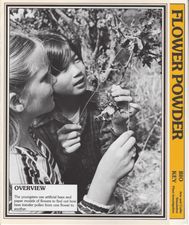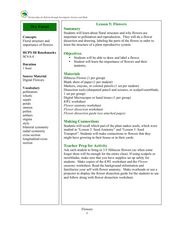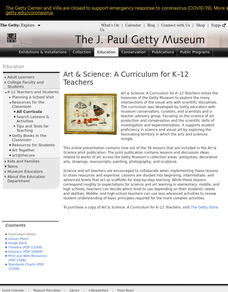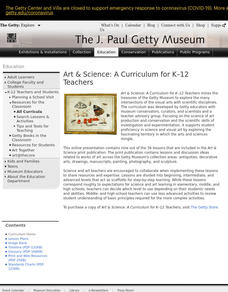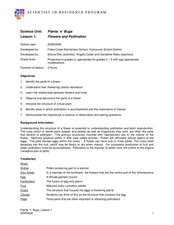Curated OER
Asexual-Sexual Reproduction
Eighth graders examine the reproductive organs of plants. In this plant reproduction activity, 8th graders identify the reproductive organs of different plants using a digital camera. Students create a plant portfolio of images large...
Curated OER
Flower Powder
Students collect and observe pollen. In this plant reproduction biology activity, students use pollen boards to collect pollen from flowers, then match it with the correct paper flowers. Students move artificial bees from flower to...
Curated OER
Flower Power
Students use video learning to explore how flowers make seeds and dissect their own flower, and make a flower with its reproductive parts out of construction paper.
Curated OER
Insects Around Us
Students fill out worksheets about insects and how they are helpful to our world. For this insects lesson plan, students learn about flower parts and insects that pollinate them.
Curated OER
Dry Forest: Flowers
Learners explore botany by examining diagrams. In this plant reproduction instructional activity, students define a list of plant vocabulary terms and identify plant anatomy from a diagram. Learners complete several plant activity...
Curated OER
Growing Pains
Students compare common food items with the parts of a plant. They grow their own plants to assess the difficulties in assisting a plant's growth and reproduction.
Curated OER
Cell Structures and Their Functions
Life science learners investigate live cells. They examine wet mount slides of cyanobacteria and Elodea plants. They peer into the dynamic microscopic world of protists. Afterward, they construct a model of a cell, including rudimentary...
Curated OER
What Bees Eat
Students study plant and animal interdependence by studying bees and pollination. In this interdependence lesson, students discuss flower parts and dissect it to show its reproductive parts. Students then use tissue and pipe cleaners to...
Curated OER
Lesson 2: the Cell Cycle
Students explain how cells reproduce. In this biology lesson, students explain the different stages of the cell cycle. They calculate the number of new cells produced.
Curated OER
Goals of the Diversity of Life Unit
Students are introduced to the unit on the importance of diversity of life and the role that interdependence plays in our worlds. this is part of a multi-lesson unit on the diversity of life.
Curated OER
Tackling Taxonomy
Students study physical characteristics of separate phyla and place them into similar groups. This instructional activity is part of a multi-segmented unit on the diversity of life. students develop a classification system by grouping...
Curated OER
Clearly Classified
Learners investigate plants and insects. In this science classification lesson plan, students create separate categories for insects and plants by characteristics. Learners discover scientific names of insects.
Curated OER
Life As A Tree
Third graders design a plate to represent the three parts of a tree. In this tree parts lesson plan, 3rd graders learn about the functions of each part and design the plate to resemble the rings of the tree.
Curated OER
Pollination
Third graders discuss pollination and how bees pollinate flowers. For this pollination lesson plan, 3rd graders draw the pollination process on a piece of paper.
Curated OER
Fiber of Life
Students examine the importance of plants to individuals and society through a multi-discipline set of activities. They observe and draw different leaf structures and then create a book about trees and photosynthesis. They explore ways...
Curated OER
Pollination Power
Students go out into the garden and observe pollinating animals through hand lenses. In this pollination lesson plan, students also discuss how animals carry seeds to create new plants elsewhere.
Curated OER
Mythical Animals
Pupils create imaginary animals by assembling pictures of body parts from pictures of real animals. This is one of three linked tasks. The others are "Who's Parts Do I Have?" and "Animals Piece by Piece."
Curated OER
Clearly Classified
Young scholars review the classification system for living organisms and apply it the classification of insects and flowers in the still life by Ambrosius Bosschaert. They create a chart classifying the animals and plants in the painting...
Curated OER
Allelopathy Experiments
Students explore how allelopathy works in plants. In this botany lesson, students explain how this phenomenon affect other organisms. They read and analyze an article about allelopathy and discuss its flaws.
Curated OER
Too Bee Or Not To Bee
Students recognize that bees are important in the reproduction of plants and to the survival of animals. In this bee lesson, students become familiar with the parts of bees and how those adaptations help them pollinate plants....
Curated OER
Flowers and Pollination
Students explore the environment by researching plant reproduction. In this pollination lesson, students define botany related vocabulary terms such as disc flower, petal and fertilization. Students dissect a flower with their classmates...
Curated OER
Seed Diversity
Learners explore agriculture by researching different seeds. In this seed identification lesson, students collaborate in small groups to analyze a package of different seeds. Learners utilize a magnifying glass to examine each seed...
Curated OER
Plant Pollination and Fertilization
Fourth graders research and apply knowledge about plant pollination and fertilization in this lesson. They color on a flower diagram the anther, the pistil, the pollen, the pollen tube, the ovary, and the egg to show the process of...
Curated OER
Animals Piece by Piece
Students sort organisms and objects into groups according to their parts and describe how the groups are formed.They identify body parts of animals from puzzle pieces, assemble the puzzle, and name the animal.

